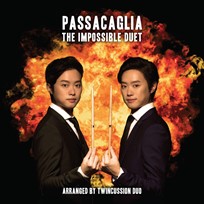
Passacaglia - The Impossible Duet
Composer: Georg Friedrich Händel
Instrument: Two Marimbas
Level: Advanced
Published: 2019
Price: €20.00
Item details
-
Description +
-
Duration: approx. 7 min.
Arranged by Twincussion Duo
A passacaglia is a musical form that originated in early seventeenth-century Spain and is still used today by composers. It is usually of a serious character and is often, but not always, based on a bass-ostinato and written in triple metre.
This piece is transcribed by Twincussion Duo, they got the inspiration from both George Frideric Handel's Harpsichord Suite in G minor and the arrangement by the Johan Halvorsen: „The Impossible Duet" for violin and cello.
The duo use different sound experiments on marimbas to imitate the strings' articulation and approaches. I.G. Playing on the edge of the bar to sound like a pizzicato…The arrangement keeps the delicacy of the strings and also shows the virtuosity and warm sound with the two marimba players.
Special thanks to Johan Bridger and Morten Friis for their kind and valuable advice for the arrangement.
-
-
Instrumentation +
-
Two Marimbas
-
-
Watch+
-
About the composer +
-
George Frideric (or Frederick) Handel was a German, later British, Baroque composer who spent the bulk of his career in London, becoming well known for his operas, oratorios, anthems, and organ concertos. Handel received important training in Halle and worked as a composer in Hamburg and Italy before settling in London in 1712; he became a naturalised British subject in 1727. He was strongly influenced both by the great composers of the Italian Baroque and by the middle-German polyphonic choral tradition.
-
-
Reviews +
-
Review (Percussive Notes, June 2020)
The Twincussion Percussion duo, comprised of Taiwanese twin brothers Jen-Ting and Jen-Yu Chien, has been gaining popularity quickly in the global percussion community. While performing at a PASIC 2018 showcase concert, the brothers demonstrated a high level of musical excellence and engagement that was truly entertaining. During this tour, the duet performed their newly published arrangement “Passacaglia (The Impossible Duet)” for two marimbas. The entire piece is a loose transcription of Johan Halvorsen’s “Passacaglia”—given the nickname “The Impossible Duet”—for violin and cello. Halvorsen created his piece from the “Passacaglia” movement of Handel’s “Suite in G minor,” with alterations and additional material that suit a much more dramatic and technically-impressive duet.
For the most part, the marimba adaptation is very similar, with a few small flourishes and additions added to enhance musical phrases for the keyboards. Player 1 maintains the violin part throughout, while Player 2 takes on the cello (which is why only one player needs a 5-octave marimba). The parts are each very intricate and use a large range of the instrument, so two keyboards are necessary. Each part requires skill to perform the duet effectively; both include fast thirty-second-note passages, quick-moving double stops, and significant interval challenges. On top of the individual part difficulties, the duet as a whole requires teamwork and trust. As a theme-and-variations composition, several of the variations begin with a completely new tempo and style, which both players must capture immediately.
Both Halvorsen and Twincussion’s arrangements make good use of the building intensity inherent in any good passacaglia. Starting off relatively slow with a clear theme and accompaniment, the piece swerves through rhythmic manipulations as well as exciting, flourishing impact moments that lead the listener through the weaving interplay of ideas. Twincussion’s use of timbral elements, such as playing on the nodes or the edge of the bars, helps to emulate the effects a string instrument can achieve while also capitalizing on the inherent strengths of the marimba.
“Passacaglia (The Impossible Duet)” is a phenomenal piece for cello and violin, and for those daring to put this on a marimba, a phenomenal work for two percussionists as well.
—Matthew Geiger
-
-
Credits +
-
Front Cover Design: Ronni Kot Wenzell
Engraving: Johan Svitzer
Printed in Copenhagen, Denmark
Copyright © Edition SVITZER
www.editionsvitzer.com
-



